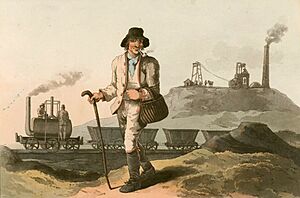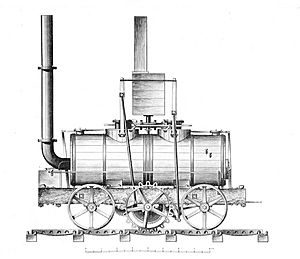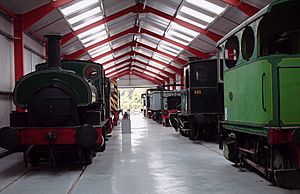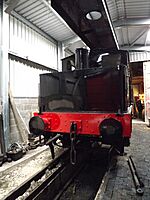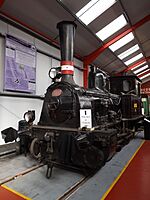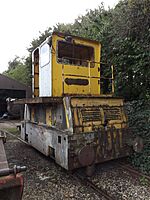Middleton Railway facts for kids
Quick facts for kids Middleton Railway |
|
|---|---|
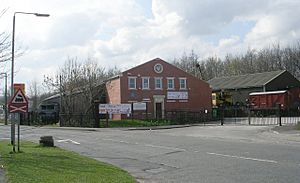
Main station building on Moor Road.
|
|
| Locale | Hunslet, Leeds, West Yorkshire |
| Terminus | Moor Road |
| Coordinates | 53°46′30″N 1°32′19″W / 53.775070°N 1.538600°W |
| Commercial operations | |
| Name | Middleton Railway |
| Built by | Charles Brandling |
| Original gauge | 4 ft 1 in (1,245 mm) until 1881 4 ft 8 1⁄2 in (1,435 mm) standard gauge from 1881 |
| Preserved operations | |
| Owned by | The Middleton Railway Trust Ltd. |
| Operated by | The Middleton Railway Trust Ltd. |
| Stations | 2 |
| Length | 0.96 miles (1.54 km) |
| Preserved gauge | 4 ft 8 1⁄2 in (1,435 mm) standard gauge |
| 1758 | Construction of first waggonway |
| 1799 | Wooden tracks replaced with iron edge rails |
| 1812 | Introduction of steam locomotives |
| c. 1835 | Line reverts to horse drawn trains |
| 1866 | Return of steam locomotives |
| 1881 | Line converted to 4 ft 8 1⁄2 in (1,435 mm) standard gauge |
| 1947 | Rationalisation of the Line |
| 1960 | Line taken over by preservation society |
| Preservation history | |
| June 1960 | One week passenger service |
| 1960 | Start of freight service |
| 1969 | Start of regular passenger service |
| 1983 | End of freight service |
| Headquarters | Moor Road station |
| Website | |
| http://www.middletonrailway.org.uk/ | |
The Middleton Railway is a very old railway in Leeds, England. It started way back in 1758 and has been running ever since! Today, it's a special heritage railway, which means it's kept alive by amazing volunteers from The Middleton Railway Trust Ltd. They've been running it since 1960.
You can ride on this railway on weekends and holidays. It travels about 1 mile (1.6 km) between its main station at Moor Road in Hunslet and Park Halt, which is near Middleton Park.
Contents
How the Railway Started
People have been digging for coal in Middleton since the 1200s. At first, they used simple pits. Later, they dug tunnels into the ground. Anne Leigh, who owned the Middleton lands, married Ralph Brandling. Their family, including Charles Brandling, managed the coal pits.
In 1754, Charles Brandling faced a problem. Other coal mines could send their coal to Leeds by river, which was cheaper. To compete, Charles Brandling decided to build a "waggonway." This was a special track for wagons, common in his home area. The first waggonway was built in 1755. It crossed his land and friendly neighbours' land to reach the river.
In 1757, Charles Brandling wanted to build another waggonway closer to Leeds. To make sure it would last, he got a special law passed by Parliament. This law, called the Middleton Railway Act 1757, was the very first law to allow a railway to be built!
The Middleton Railway was the first railway to get permission from Parliament. It helped move coal cheaply from the Middleton mines to a loading area in Leeds, near the River Aire. Not all the land belonged to Brandling, so the law gave him permission to use other people's land. The railway was paid for and run by private owners. At first, horses pulled the wagons on wooden tracks. Around 1799, the wooden tracks were replaced with stronger iron tracks.
Because Middleton coal was cheap, Leeds grew into a big industrial city. Many factories and businesses used coal for heat and power.
The First Steam Trains
In 1812, the Middleton Railway made history! It became the first railway to successfully use steam locomotives for commercial use. John Blenkinsop, the mine manager, had a clever idea. He knew that a regular engine might not grip the track well enough, especially with heavy coal wagons and steep hills.
So, he added a special "toothed rail" to one side of the track. He got a patent for this idea in 1811, creating the first rack railway. He then asked Matthew Murray to design a locomotive with a pinion (a toothed wheel) that would fit into this special rail. Murray's engine was probably named Salamanca. It was the first locomotive to use two cylinders, which helped it start easily.
Salamanca was the first commercial steam locomotive to work well. Three more locomotives were built for the Middleton coal mine. These steam engines ran on the railway for over twenty years.
The Middleton Railway also had other "firsts." It was the first railway to regularly use steam locomotives for freight. This meant it was also the first to have a train driver! The world's first regular, professional train driver was James Hewitt. He was a former mine worker who learned to drive from the engine builders. Sadly, the first person killed by a locomotive was a 13-year-old boy named John Bruce in February 1813. He was running alongside the tracks.
Even though the steam engines were amazing, not everyone was impressed at first. A child named David Joy, who later became a famous engineer, remembered seeing it:
I lived near the old coal railway. We used to see the steam from the engines. Someone told me it would come like lightning, but it just rumbled along like a cart.
Accidents and Horses Return
On February 28, 1818, Salamanca's boiler exploded. The driver was killed. This happened because the driver had changed the safety valves. Another boiler exploded on February 12, 1834, also killing the driver. This time, the boiler was likely old and worn out. The driver killed was James Hewitt, the world's first regular locomotive driver.
The Blenkinsop engines worked for thirty years. Even in 1829, visitors saw them pulling heavy loads of coal. At least two were still working until 1835.
After these accidents, horses were used again to pull the wagons. Steam engines were mostly stopped, except for a short section near the main mine.
Steam Returns Again
Steam locomotives came back to the railway in 1866. These were tank engines from a local company called Manning Wardle. In 1881, the railway tracks were changed to the standard size used by most railways in the UK. This allowed it to connect with the Midland Railway. Later, it also connected to the Great Northern Railway in 1899.
In 1947, the Middleton Estate & Colliery Co became part of the national National Coal Board. Some parts of the railway were closed. Coal was mainly moved on the line between the Great Northern Railway connection and Broom Pit.
In 1960, a group of people who wanted to save the railway, mostly from Leeds University, were allowed to use an old part of the line. When Broom Pit closed in 1968, these preservationists, now called the Middleton Railway Trust, were able to connect the line again. This kept the railway running continuously.
Saving the Railway
In June 1960, the Middleton Railway became the first standard-gauge railway to be taken over and run by volunteers. At first, they ran passenger services for just one week. They used a large double-deck tram pulled by a diesel locomotive.
However, the volunteers then started a freight service in September 1960, which ran until 1983. Regular passenger services began in 1969.
The Middleton Steam Railway is now home to many locomotives. These engines were built in the local area by famous Leeds manufacturers like John Fowler & Co., Hudswell Clarke, Hunslet Engine Company, Kitson & Co. and Manning Wardle. One of the locomotives, "Sir Berkeley," was even in the 1968 BBC TV show "The Railway Children"! This locomotive is owned by the Vintage Carriages Trust.
Railway Route and Stations
The railway line actually starts with the Balm Road Branch. This branch connects the Middleton Railway to the main Leeds - Sheffield railway lines. However, this connection has not been used since 1990. This part of the track crosses Beza Road, Tulip Street, and Moor Road. It is only used for special events because the line needs upgrades for regular use.
Just a few yards from the Moor Road crossing is the main station, Moor Road station. Here, you'll find the Engine House museum and workshops. There's also a platform for trains. This spot used to be a junction where lines connected to the Midland Railway and a coal loading area in the city center.
Leaving Moor Road, you'll see locomotives and wagons stored on side tracks before the tunnel. This tunnel is the only one on the route. It allows the railway to pass under the M621 motorway. It's about 263 feet (80 meters) long. Right after the tunnel, there's a junction for the Dartmouth Branch. This short line used to connect local metal factories to the main railway. It's sometimes used for special events and for training railway workers.
After the Dartmouth Branch, the line enters Middleton Park. The railway passes the John Charles Centre for Sport on one side and the South Leeds Academy on the other. There are two bridges in this section: one for a road and another footbridge connecting the school and sports center.
Park Halt railway station is the current end of the line. It's located near where the Broom Pit coal mine used to be, on the edge of Middleton Park. In the past, other branches continued further into the park. The station has a platform for Middleton Park and a loop for trains to turn around.
There have been talks for many years about extending the railway further into Middleton Park. It's a long-term goal for the railway to go deeper into the park. However, this would require a lot of construction work and money.
Images for kids
-
M621 tunnel north end.
Locomotives and Rolling Stock
The Middleton Railway has many different trains! They have steam engines, diesel engines, and even some old passenger cars.
Steam Locomotives
| Number / Name | Type | Builder | Notes | Image |
|---|---|---|---|---|
| Working Now | ||||
| 2387 Brookes No.1 | 0-6-0ST | Hunslet Engine Company | This engine used to look like a famous tank engine character. It was later changed back to its original look. It started working again in August 2017 after a big repair. It's one of the main engines used today. |  |
| 3860 No. 6 | 0-4-0ST | Hawthorn Leslie and Company | This engine worked at a cement factory. It was once named after a famous train character, but that name is no longer used. It started working again in September 2021. It's another main engine used today. |  |
| 1210 Sir Berkeley | L Class 0-6-0ST | Manning Wardle | This engine is on loan from the Vintage Carriages Trust. It returned to service in 2023 after being repaired by the Middleton Railway. It's part of the main group of engines that run the railway. | 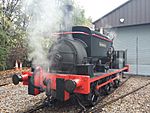 |
| LNER No. 54 / BR No. 68153 / Departmental No. 57 | LNER Class Y1 0-4-0VBT | Sentinel Waggon Works | This engine returned to service in 2021. It needs more work before it can be used regularly for passengers. For now, it's on display in the museum. | |
| Being Repaired | ||||
| 1544 Slough Estates No. 3 | 0-6-0ST | Hudswell Clarke | Built in 1924. It arrived in November 2011. Its repair started in 2022. Parts of it are taken apart, and work is being done on its boiler. It is hoped to be working again in 2024. | 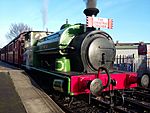 |
| 1493 No. 11 | 0-4-0ST | Hunslet Engine Company | This engine is being restored. It moved to Middleton Railway in 2000 and has been worked on for over 20 years. It's a long-term project that will be finished when time and money are available. | |
| On Display | ||||
| 1310 | NER Class H / LNER Class Y7 0-4-0T | Gateshead Railway Works | This engine was working until July 2023. Now it's on display in the Engine House museum, waiting for its next big repair. |  |
| 385 | Chemnitz 0-4-0WT | Richard Hartmann | This engine used to be in Denmark. It worked until 1999. Now it's on display in the Engine House museum. | |
| 1309 Henry De Lacy II | 0-4-0ST | Hudswell Clarke | This engine has been cleaned up and is on display in the Engine House museum. You can even go inside its cab! | 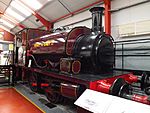 |
| 1369 M.S.C. No.67 | 0-6-0T | Hudswell Clarke | This engine stopped working in January 2012. It is now on display in the Engine House museum. | 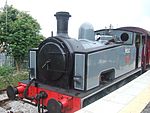 |
| 1601 Matthew Murray | L Class 0-6-0ST | Manning Wardle | This engine returned to service in June 2010. It stopped working in 2021. It needs expensive repairs, including a new part for its engine. | 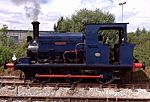 |
| 1882 Mirvale | 0-4-0ST | Hudswell Clarke | This engine is on display in the Engine House Museum. You can go inside its cab. |  |
| 526 Hawarden | 0-4-0ST | Hudswell Clarke | Built in 1899. It arrived from another museum in 2024. | 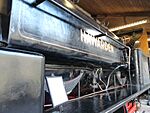 |
| 5469 Conway | 0-6-0ST | Kitson and Company | This engine was sent for cleaning and minor repairs for display. It returned in 2022. The Middleton Railway plans to finish cleaning it up when they have time and money. It's currently on display. | |
| Stored | ||||
| 1540 Picton | 2-6-2T | Hunslet Engine Company | This engine originally worked on a sugar cane railway far away. It was brought to England for preservation. Many parts were rusted and removed. In 2016, a special shelter was built for it. It was painted black in 2020 to protect it. The railway hopes to fully restore its appearance later. |  |
| 1684 | 0-4-0T | Hunslet Engine Company | This engine is stored indoors. It needs a lot of work to be restored because it's in poor condition. The railway hopes to restore it one day, but other repairs are more important right now. |  |
| 2003 John Blenkinsop | 0-4-0ST | Peckett and Sons | This engine is stored at another railway museum. It received some cleaning there. The Middleton Railway hopes to bring it back and fully restore it, but it will take a lot of time and money. | 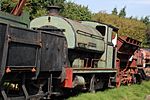 |
Diesel and Electric Locomotives
| Number / Name | Type | Builder | Notes | Image |
|---|---|---|---|---|
| Working Now | ||||
| 45 | 0-6-0DM | Hudswell Clarke | This is the main diesel engine used on the railway. It arrived in September 2017. It's often used on Saturday diesel train days and as a backup engine. |  |
| D577 Mary | 0-4-0DM | Hudswell Clarke | Built in 1932. It's on display in the museum and sometimes used for special events. |  |
| D631 Carroll | 0-4-0DM | Hudswell Clarke | Built in 1946. It's on display in the museum and sometimes used for special events. |  |
| 1697 John Alcock | LMS diesel shunter 7051 0-6-0DM | Hunslet Engine Company | This was the first locomotive owned by the Middleton Railway Trust. It's on display in the museum and sometimes used for special events. | 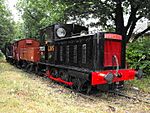 |
| 1786 Courage | 0-4-0DM | Hunslet Engine Company | Named after the brewery where it worked. It's also called Sweet Pea. It can only run with another locomotive because it doesn't have certain brakes. It's mainly used during special events. | 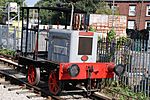 |
| 5003 Austins No. 1 | 0-4-0DM | Peckett and Sons | Built in 1961. It arrived in 2001. It's regularly used on the Saturday diesel service. | 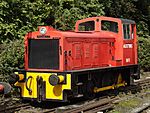 |
| D2999 Alf | British Rail Class D2/11 0-4-0DE | Brush/Beyer Peacock | This engine started working in 2015. It's regularly used on the Saturday diesel service. | 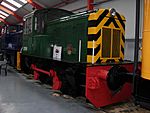 |
| 4220033 Harry | 0-4-0DM | John Fowler & Co. | This engine returned to service in 2016. In 2019, it was damaged, but repairs were completed, and it returned to service in late 2022. It's regularly used on the Saturday diesel service. |  |
| Not Working | ||||
| 6981 | 0-4-0DM | Hunslet Engine Company | This engine is being restored. It needs a full engine repair and other work before it can carry passengers. It arrived in 2011 and is expected to be finished in 2023–2024. | |
| 420452 | Coke Oven locomotive | Greenwood and Batley | This is an electric locomotive built in 1979. It's stored indoors but not on public display because there isn't enough space. | |
| DB998901 Olive | Overhead Line Inspection Vehicle | Drewry Car Co. | Built in 1950. It was damaged in 2016. It received major body repairs. It is waiting for money and resources to fix its inside and mechanical problems. It's not known when it will return to service. | 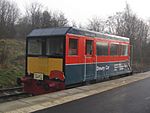 |
| 3900002 | 0-4-0DM | John Fowler & Co. | This engine is on display in the Engine House. Its engine doors were removed so visitors can see how it works. | 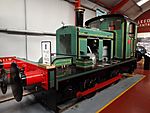 |
Trams
Some trams were saved from another railway and brought to Middleton Railway. However, they were damaged and destroyed by fire.
| Number / Name | Type | Builder | Notes | Image |
|---|---|---|---|---|
| Scrapped | ||||
| No. 2 | Double Deck Tram seating 106 passengers | Brush Electrical Company | Built around 1929. It was destroyed by fire. | 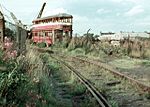 |
Rolling Stock
| Number / Name | Type | Builder | Notes | Image |
|---|---|---|---|---|
| Passenger Cars | ||||
| 1867 | PMV Standard Brake | Southern Railway | This car was changed from an old van. It has heating. | 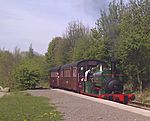 |
| 2084 | PMV Standard Trailer | Southern Railway | This car was changed from an old van. It has heating. | |
| 1074 | PMV Standard Brake | Southern Railway | This car was changed from an old van. It has heating and is designed for easier wheelchair access. | |
| 860E | Brake Van | Birmingham Railway Carriage & Wagon works | This car can hold 10 people. It's often used during special events and on Santa trains. It has special brakes. | |
| 158760 | LMS Brake Van | LMS (Derby) | This car has been fully restored, including all its wooden parts. It's rarely used because it's very heavy. It's currently on display in the museum, and you can go inside. | 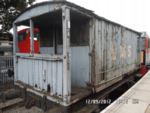 |


